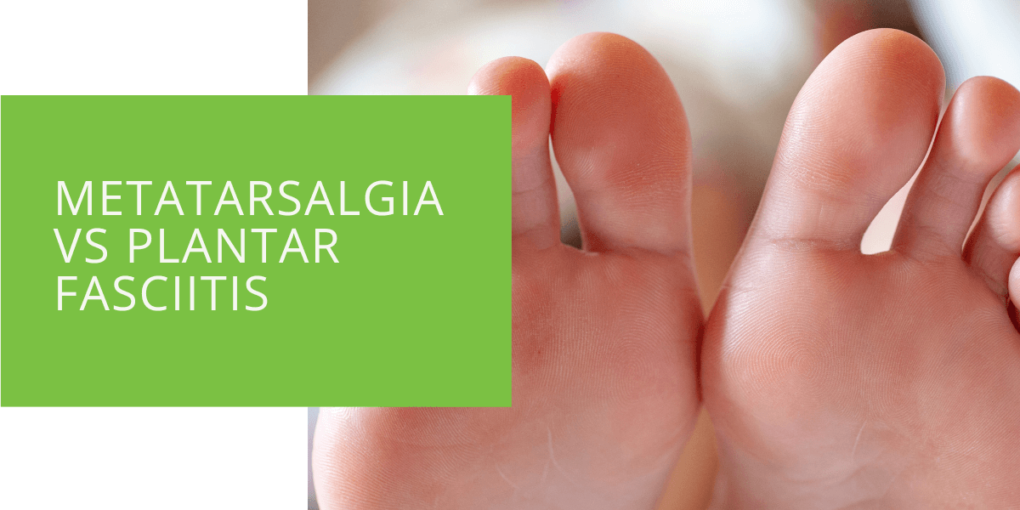Metatarsalgia vs Plantar Fasciitis
If you're experiencing pain in your foot, you may wonder if it's metatarsalgia or plantar fasciitis. These two conditions are similar in that they both affect the feet and can cause discomfort, but they have some important differences. Understanding these differences can help you get the right diagnosis and treatment for your foot pain. This article will explain the differences between metatarsalgia and plantar fasciitis, including their symptoms, causes, and treatment options.
What Is Metatarsalgia?
Metatarsalgia is a condition that causes pain and discomfort in the ball of the foot, specifically in the area just behind the toes. The term "metatarsalgia" comes from the Greek words "meta", meaning "behind", and "tarsus", meaning "ankle," so it refers to pain in the metatarsal region of the foot. Various factors, including overuse, injury, or structural abnormalities of the foot can cause Metatarsalgia.

Symptoms of Metatarsalgia
The main symptom of metatarsalgia is a pain in the ball of the foot, which may be sharp, aching, or throbbing. The pain may be worse when walking or standing for long periods and may be relieved by sitting or resting the foot. Other symptoms of metatarsalgia may include swelling, numbness, or tingling in the affected area.
Causes of Metatarsalgia
Several factors can contribute to the development of metatarsalgia. Some common causes include:
- Overuse: Repetitive stress on the ball of the foot, such as from running or dancing, can lead to metatarsalgia.
- Structural abnormalities: People with high arches or flat feet may be more prone to metatarsalgia, as these foot structures can put extra pressure on the ball of the foot.
- Tight shoes: Wearing shoes that are too tight or have high heels can put extra pressure on the ball of the foot and lead to metatarsalgia.
- Fractures or injuries: Traumatic injuries to the ball of the foot, such as fractures or sprains, can cause metatarsalgia.
Treatment Options for Metatarsalgia
The treatment for metatarsalgia will depend on the underlying cause of the condition. Some common treatment options include:
- Rest: Taking a break from activities that put pressure on the ball of the foot can help alleviate metatarsalgia.
- Ice: Applying ice to the affected area can help reduce swelling and pain.
- Stretching: Stretching the muscles and tendons in the foot can help improve flexibility and reduce pressure on the ball of the foot.
- Orthotic inserts: Wearing orthotic inserts in your shoes can help distribute pressure more evenly across the foot and reduce the risk of metatarsalgia.
- Physical therapy: Working with a physical therapist can help improve the strength and flexibility of the muscles and tendons in the foot, which can help prevent metatarsalgia.
- Surgery: In rare cases, surgery may be necessary to correct structural abnormalities or remove bone spurs contributing to metatarsalgia.
What Is Plantar Fasciitis?
Plantar fasciitis is a condition that causes pain and inflammation in the plantar fascia, a band of tissue that runs along the bottom of the foot from the heel to the toes. The plantar fascia helps support the arch of the foot and provides cushioning when you walk or run. When the plantar fascia becomes inflamed, it can cause pain and discomfort, especially when walking or standing. Plantar fasciitis is a common condition that can affect people of all ages, but it is more common in people who are overweight, has flat feet, or engage in activities that put a lot of strain on the feet.

Symptoms of Plantar Fasciitis
The main symptom of plantar fasciitis is a pain in the heel or arch of the foot, which may be sharp or aching. The pain is often worse in the morning or after periods of inactivity, and it may improve with activity or stretching. Other symptoms of plantar fasciitis may include swelling or tenderness in the heel or arch of the foot and difficulty standing on tiptoe.
Causes of Plantar Fasciitis
Several factors can contribute to the development of plantar fasciitis. Some common causes include:
- Overuse: Repetitive stress on the plantar fascia, such as running or jumping, can lead to plantar fasciitis.
- Flat feet: People with flat feet or low arches may be more prone to plantar fasciitis, as the plantar fascia may be stretched more than usual.
- High arches: People with high arches may also be at risk of plantar fasciitis, as the plantar fascia may be stretched too much.
- Tight muscles: Tight muscles in the calf or heel may cause the plantar fascia to become strained, leading to plantar fasciitis.
- Weight gain: Gaining weight can put extra strain on the feet and increase the risk of plantar fasciitis.
Treatment Options for Plantar Fasciitis
Treatment for plantar fasciitis will depend on the severity of the condition and the underlying cause. Some common treatment options include:
- Rest: Taking a break from activities that strain the feet can help alleviate plantar fasciitis.
- Ice: Applying ice to the affected area can help reduce swelling and pain.
- Stretching: Stretching the muscles and tendons in the foot and calf can help improve flexibility and reduce strain on the plantar fascia.
- Orthotic inserts: Wearing orthotic inserts in your shoes can help distribute pressure more evenly across the foot and reduce the risk of plantar fasciitis.
- Physical therapy: Working with a physical therapist can help improve the strength and flexibility of the muscles and tendons in the foot, which can help prevent plantar fasciitis.
- Surgery: In rare cases, surgery may be necessary to release the plantar fascia or remove bone spurs contributing to plantar fasciitis.

Differences Between Metatarsalgia and Plantar Fasciitis
Although metatarsalgia and plantar fasciitis are both foot conditions that can cause pain and discomfort, there are some important differences between the two.
Location of Pain
One of the main differences between metatarsalgia and plantar fasciitis is the location of the pain. Metatarsalgia affects the ball of the foot, while plantar fasciitis affects the heel or arch of the foot. This can be a helpful clue in identifying which condition you may be experiencing.
Underlying Causes
The underlying causes of metatarsalgia and plantar fasciitis can also be different. Metatarsalgia is often caused by overuse, structural abnormalities, or tight shoes, while overuse, flat or high arches, tight muscles, or weight gain often cause plantar fasciitis. Understanding the underlying cause of your foot pain can help your healthcare provider determine the most effective treatment approach.
Treatment Approaches
The treatment approaches for metatarsalgia and plantar fasciitis may also differ, depending on the specific cause and severity of the condition. Both conditions may be treated with rest, ice, stretching, and orthotic inserts, but more advanced treatments, such as physical therapy or surgery, may be necessary for more severe cases. Working with a healthcare provider, such as a podiatrist or orthopedic specialist, is important to determine the best treatment approach for your specific condition.
Conclusion
Metatarsalgia and plantar fasciitis are common foot conditions that cause pain and discomfort. Although they have some similarities, there are also important differences between the two conditions, including the location of the pain, underlying causes, and treatment approaches. If you're experiencing foot pain, it's important to see a healthcare provider, such as a podiatrist, for a proper diagnosis and treatment plan. You can relieve your foot pain and get back to normal activities with the right care.

